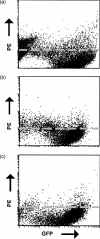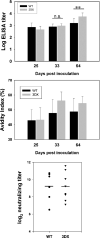A live guinea pig cytomegalovirus vaccine deleted of three putative immune evasion genes is highly attenuated but remains immunogenic in a vaccine/challenge model of congenital cytomegalovirus infection
- PMID: 19389443
- PMCID: PMC3539795
- DOI: 10.1016/j.vaccine.2009.04.036
A live guinea pig cytomegalovirus vaccine deleted of three putative immune evasion genes is highly attenuated but remains immunogenic in a vaccine/challenge model of congenital cytomegalovirus infection
Abstract
Live attenuated vaccines for prevention of congenital cytomegalovirus infections encode numerous immune evasion genes. Their removal could potentially improve vaccine safety and efficacy. To test this hypothesis, three genes encoding MHC class I homologs (presumed NK evasins) were deleted from the guinea pig cytomegalovirus genome and the resulting virus, 3DX, was evaluated as a live attenuated vaccine in the guinea pig congenital infection model. 3DX was attenuated in vivo but not in vitro. Vaccination with 3DX produced elevated cytokine levels and higher antibody titers than wild type (WT) virus while avidity and neutralizing titers were similar. Protection, assessed by maternal viral loads and pup mortality following pathogenic viral challenge during pregnancy, was comparable between 3DX and WT and significant compared to naïve animals. These results suggest that the safety and perhaps efficacy of live attenuated human cytomegalovirus vaccines could be enhanced by deletion of viral immunomodulatory genes.
Figures







Similar articles
-
Comparison of monovalent glycoprotein B with bivalent gB/pp65 (GP83) vaccine for congenital cytomegalovirus infection in a guinea pig model: Inclusion of GP83 reduces gB antibody response but both vaccine approaches provide equivalent protection against pup mortality.Vaccine. 2015 Jul 31;33(32):4013-8. doi: 10.1016/j.vaccine.2015.06.019. Epub 2015 Jun 13. Vaccine. 2015. PMID: 26079615 Free PMC article.
-
Inclusion of the Guinea Pig Cytomegalovirus Pentameric Complex in a Live Virus Vaccine Aids Efficacy against Congenital Infection but Is Not Essential for Improving Maternal and Neonatal Outcomes.Viruses. 2021 Nov 26;13(12):2370. doi: 10.3390/v13122370. Viruses. 2021. PMID: 34960639 Free PMC article.
-
Vaccination with a Live Attenuated Cytomegalovirus Devoid of a Protein Kinase R Inhibitory Gene Results in Reduced Maternal Viremia and Improved Pregnancy Outcome in a Guinea Pig Congenital Infection Model.J Virol. 2015 Oct;89(19):9727-38. doi: 10.1128/JVI.01419-15. Epub 2015 Jul 15. J Virol. 2015. PMID: 26178990 Free PMC article.
-
Comparison of vaccine strategies against congenital CMV infection in the guinea pig model.J Clin Virol. 2008 Mar;41(3):224-30. doi: 10.1016/j.jcv.2007.10.008. Epub 2007 Dec 3. J Clin Virol. 2008. PMID: 18060834 Review.
-
Vaccine Development for Cytomegalovirus.Adv Exp Med Biol. 2018;1045:271-296. doi: 10.1007/978-981-10-7230-7_13. Adv Exp Med Biol. 2018. PMID: 29896672 Review.
Cited by
-
Comparison of monovalent glycoprotein B with bivalent gB/pp65 (GP83) vaccine for congenital cytomegalovirus infection in a guinea pig model: Inclusion of GP83 reduces gB antibody response but both vaccine approaches provide equivalent protection against pup mortality.Vaccine. 2015 Jul 31;33(32):4013-8. doi: 10.1016/j.vaccine.2015.06.019. Epub 2015 Jun 13. Vaccine. 2015. PMID: 26079615 Free PMC article.
-
Inclusion of the Guinea Pig Cytomegalovirus Pentameric Complex in a Live Virus Vaccine Aids Efficacy against Congenital Infection but Is Not Essential for Improving Maternal and Neonatal Outcomes.Viruses. 2021 Nov 26;13(12):2370. doi: 10.3390/v13122370. Viruses. 2021. PMID: 34960639 Free PMC article.
-
Molecular and biological characterization of a new isolate of guinea pig cytomegalovirus.Viruses. 2014 Jan 27;6(2):448-75. doi: 10.3390/v6020448. Viruses. 2014. PMID: 24473341 Free PMC article.
-
Complete genome sequence of cell culture-attenuated Guinea pig cytomegalovirus cloned as an infectious bacterial artificial chromosome.Genome Announc. 2014 Oct 16;2(5):e00928-14. doi: 10.1128/genomeA.00928-14. Genome Announc. 2014. PMID: 25323707 Free PMC article.
-
Congenital cytomegalovirus infection: molecular mechanisms mediating viral pathogenesis.Infect Disord Drug Targets. 2011 Oct;11(5):449-65. doi: 10.2174/187152611797636721. Infect Disord Drug Targets. 2011. PMID: 21827434 Free PMC article. Review.
References
-
- Stagno S, Pass RF, Cloud G, Britt WJ, Henderson RE, Walton PD, et al. Primary cytomegalovirus infection in pregnancy. Incidence, transmission to fetus, and clinical outcome. Jama. 1986;256(14):1904–1908. - PubMed
-
- Bradford RD, Cloud G, Lakeman AD, Boppana S, Kimberlin DW, Jacobs R, et al. Detection of cytomegalovirus (CMV) DNA by polymerase chain reaction is associated with hearing loss in newborns with symptomatic congenital CMV infection involving the central nervous system. J Infect Dis. 2005;191(2):227–233. - PubMed
-
- Damato EG, Winnen CW. Cytomegalovirus infection: perinatal implications. J Obstet Gynecol Neonatal Nurs. 2002;31(1):86–92. - PubMed
-
- Nelson CT, Demmler GJ. Cytomegalovirus infection in the pregnant mother, fetus, and newborn infant. Clin Perinatol. 1997;24(1):151–160. - PubMed
-
- Wong A, Tan KH, Tee CS, Yeo GS. Seroprevalence of cytomegalovirus, toxoplasma and parvovirus in pregnancy. Singapore Med J. 2000;41(4):151–155. - PubMed
Publication types
MeSH terms
Substances
Grants and funding
LinkOut - more resources
Full Text Sources
Other Literature Sources
Medical
Research Materials

